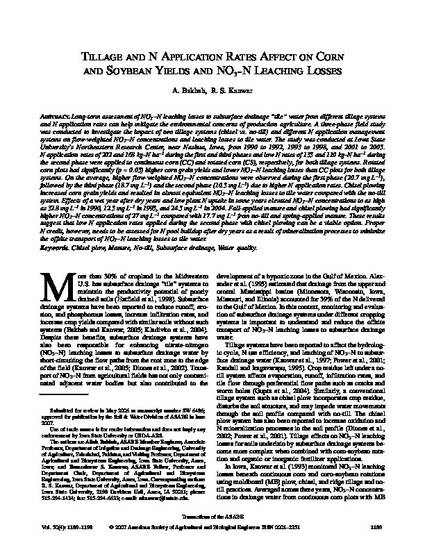
Long-term assessment of NO3-N leaching losses to subsurface drainage "tile" water from different tillage systems and N application rates can help mitigate the environmental concerns of production agriculture. A three-phase field study was conducted to investigate the impact of two tillage systems (chisel vs. no-till) and different N application management systems on flow-weighted NO3-N concentrations and leaching losses to tile water. The study was conducted at Iowa State University's Northeastern Research Center, near Nashua, Iowa, from 1990 to 1992, 1993 to 1998, and 2001 to 2005. N application rates of 202 and 168 kg-N ha-1 during the first and third phases and low N rates of 135 and 110 kg-N ha-1 during the second phase were applied to continuous corn (CC) and rotated corn (CS), respectively, for both tillage systems. Rotated corn plots had significantly (p = 0.05) higher corn grain yields and lower NO3-N leaching losses than CC plots for both tillage systems. On the average, higher flow-weighted NO3-N concentrations were observed during the first phase (20.7 mg L-1), followed by the third phase (18.7 mg L-1) and the second phase (10.5 mg L-1) due to higher N application rates. Chisel plowing increased corn grain yields and resulted in almost equivalent NO3-N leaching losses to tile water compared with the no-till system. Effects of a wet year after dry years and low plant N uptake in some years elevated NO3-N concentrations to as high as 32.8 mg L-1 in 1990, 12.5 mg L-1 in 1995, and 24.5 mg L-1 in 2004. Fall-applied manure and chisel plowing had significantly higher NO3-N concentrations of 27 mg L-1 compared with 17.7 mg L-1 from no-till and spring-applied manure. These results suggest that low N application rates applied during the second phase with chisel plowing can be a viable option. Proper N credit, however, needs to be assessed for N pool buildup after dry years as a result of mineralization processes to minimize the offsite transport of NO3-N leaching losses to tile water.
Available at: http://works.bepress.com/rskanwar/102/

This article was published in Transactions of the ASABE Vol. 50(4): 1189-1198, doi:10.13031/2013.23633. (Copyright 2007 American Society of Agricultural and Biological Engineers).